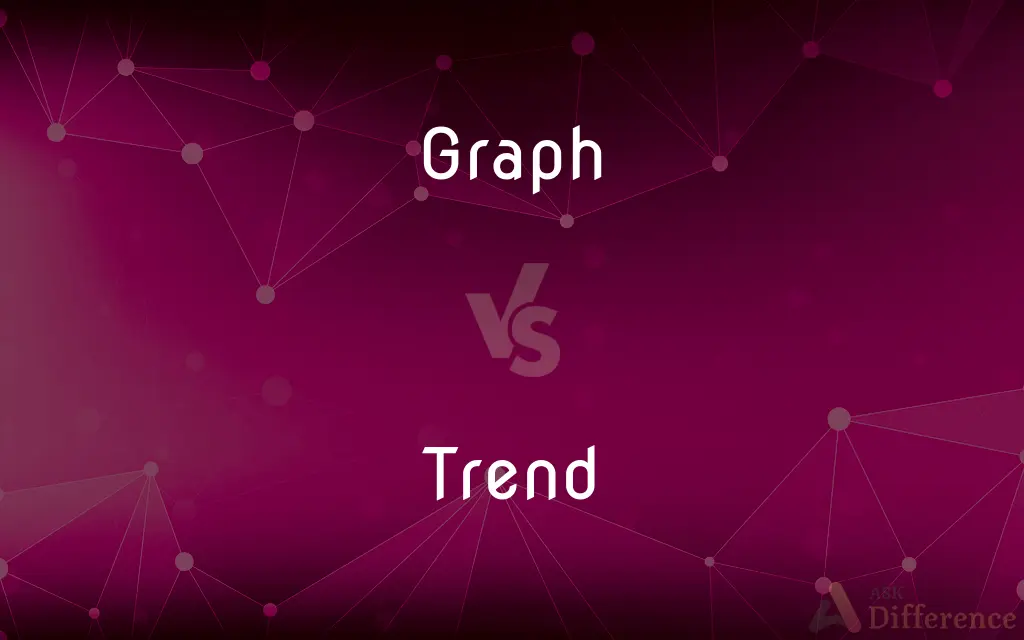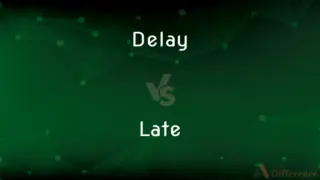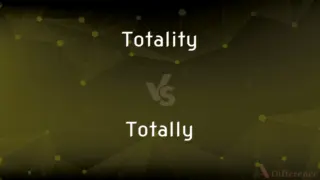Graph vs. Trend — What's the Difference?
By Urooj Arif & Fiza Rafique — Updated on May 15, 2024
A graph is a visual representation of data points connected by lines, while a trend refers to the general direction in which something is developing or changing.

Difference Between Graph and Trend
Table of Contents
ADVERTISEMENT
Key Differences
A graph displays data in a visual format, making it easier to identify patterns and relationships between variables. On the other hand, a trend indicates a general direction or pattern that emerges from data over time.
Graphs can be used to illustrate trends, using formats like line graphs or bar charts, whereas identifying a trend requires analyzing the data's movement within the graph to determine if it shows a consistent upward, downward, or neutral path.
In terms of utility, a graph is a tool used in various fields such as mathematics, science, and business to present information clearly and effectively. Conversely, a trend is more of a concept or observation used to predict future movements or to make decisions based on past data.
Graphs require specific data points to be plotted on axes, where each axis represents a different variable. Trends do not require a visual format for identification but can be discerned from data tables, financial reports, or narrative descriptions.
When communicating findings, a graph can effectively show how different variables interact over time or in comparison to each other. In contrast, discussing a trend might focus more on the implications of data movements and predictions for future outcomes based on those trends.
ADVERTISEMENT
Comparison Chart
Definition
Visual representation of data
General direction in which data is moving
Purpose
To display data points and relationships
To identify patterns and predict future movements
Example Uses
In academics, business analysis, and science
In market analysis, forecasting, and strategy planning
Data Requirement
Requires exact data points and axes
Can be identified from varied data presentations
Communication
Used to illustrate complex data simply
Used to discuss implications and predictions
Compare with Definitions
Graph
A tool used to visually communicate data.
We used a bar graph to display the company's sales performance.
Trend
A general direction in which something is developing.
The trend in technology is leaning towards more integrated devices.
Graph
Plots data points on axes.
Each point on the graph represents a week's worth of data.
Trend
Used to predict future changes.
Market trends suggest an increase in demand for electric vehicles.
Graph
Helps identify trends and patterns.
The graph helped identify the seasonal trends in customer behavior.
Trend
Can be upward, downward, or neutral.
The recent trend in coffee prices shows a steady increase.
Graph
Can be line, bar, or pie, among others.
For the presentation, prepare a pie graph of the market share.
Trend
Observed over a period of time.
Over the decade, the trend in urban development has shifted towards sustainability.
Graph
A diagram that exhibits a relationship, often functional, between two sets of numbers as a set of points having coordinates determined by the relationship. Also called plot.
Trend
Important in planning and forecasting.
Understanding consumer trends is crucial for effective product development.
Graph
A pictorial device, such as a pie chart or bar graph, used to illustrate quantitative relationships. Also called chart.
Trend
A general tendency or course of events
A warming trend.
Graph
The spelling of a word.
Trend
Current style; vogue
The latest trend in fashion.
Graph
Any of the possible forms of a grapheme.
Trend
The general direction of something
The river's southern trend.
Graph
A written character that represents a vowel, consonant, syllable, word, or other expression and that cannot be further analyzed.
Trend
To show a general tendency; tend
The magazine's circulation is trending downward.
Graph
To represent by a graph.
Trend
To undergo a rapid increase in public interest or attention
News of the earthquake is trending on social media.
Graph
To plot (a function) on a graph.
Trend
To extend, incline, or veer in a specified direction
The prevailing wind trends northeast.
Graph
A data chart (graphical representation of data) intended to illustrate the relationship between a set (or sets) of numbers (quantities, measurements or indicative numbers) and a reference set, whose elements are indexed to those of the former set(s) and may or may not be numbers.
Trend
An inclination in a particular direction.
The trend of a coastline
The upward trend of stock-market prices
Graph
(mathematics) A set of points constituting a graphical representation of a real function; (formally) a set of tuples , where for a given function . See also Graph of a function Category:en:Curves Category:en:Functions
Trend
A tendency.
There is a trend, these days, for people in films not to smoke.
Graph
(graph theory) A set of vertices (or nodes) connected together by edges; (formally) an ordered pair of sets , where the elements of are called vertices or nodes and is a set of pairs (called edges) of elements of . See also Graph (discrete mathematics)
Trend
A fad or fashion style.
Miniskirts were one of the biggest trends of the 1960s.
Graph
(topology) A topological space which represents some graph (ordered pair of sets) and which is constructed by representing the vertices as points and the edges as copies of the real interval [0,1] (where, for any given edge, 0 and 1 are identified with the points representing the two vertices) and equipping the result with a particular topology called the graph topology.
Trend
(mathematics) A line drawn on a graph that approximates the trend of a number of disparate points.
Graph
A morphism from the domain of to the product of the domain and codomain of , such that the first projection applied to equals the identity of the domain, and the second projection applied to is equal to .
Trend
(nautical) The lower end of the shank of an anchor, being the same distance on the shank from the throat that the arm measures from the throat to the bill.
Graph
A graphical unit on the token-level, the abstracted fundamental shape of a character or letter as distinct from its ductus (realization in a particular typeface or handwriting on the instance-level) and as distinct by a grapheme on the type-level by not fundamentally distinguishing meaning.
Trend
(nautical) The angle made by the line of a vessel's keel and the direction of the anchor cable, when she is swinging at anchor.
Graph
(transitive) To draw a graph.
Trend
Clean wool.
Graph
To draw a graph of a function.
Trend
(intransitive) To have a particular direction; to run; to stretch; to tend.
The shore of the sea trends to the southwest.
Graph
A curve or surface, the locus of a point whose coördinates are the variables in the equation of the locus; as, a graph of the exponential function.
Trend
(transitive) To cause to turn; to bend.
Graph
A diagram symbolizing a system of interrelations of variable quantities using points represented by spots, or by lines to represent the relations of continuous variables. More than one set of interrelations may be presented on one graph, in which case the spots or lines are typically distinguishable from each other, as by color, shape, thickness, continuity, etc. A diagram in which relationships between variables are represented by other visual means is sometimes called a graph, as in a bar graph, but may also be called a chart.
Trend
To be the subject of a trend; to be currently popular, relevant or interesting.
What topics have been trending on social networks this week?
Graph
A drawing illustrating the relations between certain quantities plotted with reference to a set of axes
Trend
To cleanse or clean (something, usually wool).
Graph
Represent by means of a graph;
Chart the data
Trend
To have a particular direction; to run; to stretch; to tend; as, the shore of the sea trends to the southwest.
Graph
Plot upon a graph
Trend
To cause to turn; to bend.
Not far beneath i' the valley as she trendsHer silver stream.
Graph
A diagram showing the relation between variable quantities.
The graph shows the relationship between time spent studying and test scores.
Trend
To cleanse, as wool.
Trend
Inclination in a particular direction; tendency; general direction; as, the trend of a coast.
Trend
Clean wool.
Trend
A general direction in which something tends to move;
The shoreward tendency of the current
The trend of the stock market
Trend
General line of orientation;
The river takes a southern course
The northeastern trend of the coast
Trend
A general tendency to change (as of opinion);
Not openly liberal but that is the trend of the book
A broad movement of the electorate to the right
Trend
The popular taste at a given time;
Leather is the latest vogue
He followed current trends
The 1920s had a style of their own
Trend
Turn sharply; change direction abruptly;
The car cut to the left at the intersection
The motorbike veered to the right
Common Curiosities
Are graphs and trends only used in business?
No, they are used in various fields, including science, education, and economics.
How do different types of graphs show trends?
Line graphs are particularly good at showing trends over time.
How can I identify a trend in data?
By analyzing the data's movement over time to see if there is a consistent direction.
Can trends be misleading?
Yes, if data is incomplete or improperly analyzed, trends can be misleading.
What happens if a trend is ignored in business planning?
It may lead to missed opportunities and misaligned strategies.
Can a single graph show multiple trends?
Yes, especially if it plots several data series.
What is a negative trend?
A trend that shows a decrease in value or undesirable outcomes.
What is the primary purpose of a graph?
To visually represent data to clarify relationships and patterns.
How often should trends be reviewed?
Regularly, as data updates and new patterns may emerge.
What tools are used to create graphs?
Software like Excel, Google Charts, and specialized statistical software.
Why is it important to understand trends?
Trends help predict future behaviors and plan accordingly.
How do trends affect forecasting?
They are fundamental to accurate forecasting by indicating expected future conditions.
Are all trends easy to spot?
Not always; some require detailed analysis and expert interpretation.
How can trends influence decision making?
Trends can guide strategic decisions by indicating what's likely to happen in the future.
What is an example of a misleading graph?
Graphs with manipulated axes or scales can misrepresent data and trends.
Share Your Discovery

Previous Comparison
Delay vs. Late
Next Comparison
Totality vs. TotallyAuthor Spotlight
Written by
Urooj ArifUrooj is a skilled content writer at Ask Difference, known for her exceptional ability to simplify complex topics into engaging and informative content. With a passion for research and a flair for clear, concise writing, she consistently delivers articles that resonate with our diverse audience.
Co-written by
Fiza RafiqueFiza Rafique is a skilled content writer at AskDifference.com, where she meticulously refines and enhances written pieces. Drawing from her vast editorial expertise, Fiza ensures clarity, accuracy, and precision in every article. Passionate about language, she continually seeks to elevate the quality of content for readers worldwide.
















































